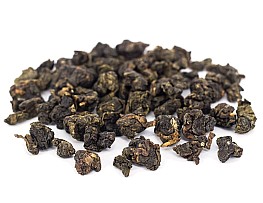2024 Assam Oolong Loose-Leaf Tea
Harvest: Autumn 2024
Elevation: 1400 m
Cultivar: C. S. var. Assamica
Availability: In Stock
Generally speaking, Assam Oolong sounds like nonsense. A proper oolong requires two components: oolong processing and oolong material, which Assamica simply isn’t.
What happens if we make an oolong from CS var. Assamica leaves? We get a "semi-black" or "over-green" tea. This is because Assamica lacks the necessary properties to provide a wide oolong flavor and aroma range. Assamica is a wonderful material, great for making pu-erhs, white teas, black or green teas. It’s perfect for aging and fermentation, and it’s not suitable for oolongs.
But! We have a special type of trees that is so unique and rich in organoleptic qualities that it makes an excellent oolong.
These are large, 200-300-year-old trees with mighty trunks, big Assamic leaves, and a bold tannic character—and yet, they produce a dense oolong flavor, multi-layered and oily.
These trees grow only in one small subdistrict, and I haven’t encountered this variety anywhere else. The previous batch (before 2024) was rather deeply roasted. The fresh autumn batch is mildly roasted, in the style of classic light Taiwanese oolongs.
Organoleptics.
Have you ever tasted an Assamica with a rich, oily, berry-like caramel at its core? Something like barberry. Plus, there are all sorts of other berries and fruits: sea buckthorn, mango, and some peculiar apples. Probably not, or not to the extent I’m referring to. Now, you have a chance to experience such a tea.
There’s a distinct, bold, and very unique melody to this tea, which is how I immediately recognize this material. In short, the light oolong processing method suits it perfectly.
The tea has a similar effect to a young sheng pu-erh—it’s pleasantly heady, uplifting, yet calming at the same time (trees in shaded jungles have more L-theanine in their leaves). These trees grow in a real forest with full biodiversity, and of course, all production is 100% organic.
If you were to compare teas from the common trees of China, Vietnam, Laos, Myanmar, or Thailand, you'd certainly notice the difference in flavor and character, but at the same time, all those teas would fit within predictable organoleptic boundaries.
This tea does not fit within those boundaries. If you're curious to try something truly unique and Thai, then we await your orders — I haven’t encountered anything like it, not even from Chinese varieties.
Reviews (3)
Decent oolong, both in flavor and tea state, similar to sheng, but not much, in general oolong liked, easy to drink, long pleasant aftertaste.
Bolder than most wulongs at Teaside. Wulong drinkers will still recognize its familiarity while also appreciating the distinct Assamica leaf from which its made.
Nice and light. There is a slight tartness/astringency with a sweet after taste.
A little floral and a little fruity.
Though it has a light aroma and taste, it has a medium-body mouth feel. Somewhat dry.
The sensation of this tea similar to drinking a mild sheng puerh. I feel more alert after drinking this tea.
Wet leaves resemble that of sheng puerh too.










